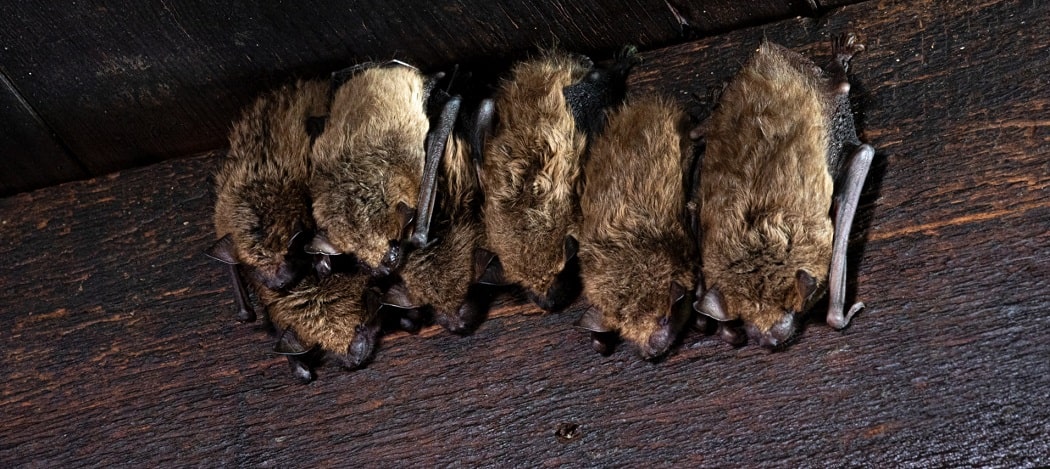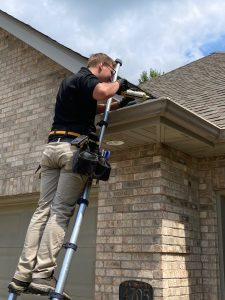
Understanding when bats give birth can help you protect your house from bat infestation. Bats are dangerous to people, but bats in the attic, walls, or chimney should not be ignored.
Bats are most likely to roost inside your house during bat maternity season. When bats give birth, they need to find a safe place. Pups need weeks before they are strong enough to fly on their own. During this time, they are dependent on the mother.
About Bat Maternity Season
Bats are pregnant for about six to nine weeks and usually give birth to one pup. Some species can give birth to twins. At the beginning of spring, female bats will gather in maternity roosts, and it is at this time that you will most likely attract bats to your attic. They roost together to keep the pups warm and protect themselves from predators. Baby bats are born blind and helpless. They are completely dependent on their mothers for about four to five months. In about August or September, when their wings have developed sufficiently for flight, they are weaned. Once they are old enough, they join their mothers to forage for food. This is the best time to eliminate them from your home.
Why Bats Are Not Removed During Maternity Season
Bat removal poses an added challenge for homeowners who suspect bats in their attic: bat maternity season. Unlike other nuisance animals, bats are protected by state and federal law. Some are endangered. Because of this, bats and their young pups cannot be separated or harmed. Many states specify a maternity season during which wildlife protection laws exist. For instance, Florida’s bat maternity season is from April 15 to August 15. During this time, it’s illegal to block bats from their roosts.
On the whole, bats play an important and beneficial role in our ecosystem. Loss of habitat, white-nose syndrome, and their low maternity rate are contributing to their declining numbers. If bats were exterminated during their maternity season, their pups would not survive. Without a healthy bat population, we would lose some of these vital benefits:
- Pest Control: A single bat can catch up to 1,000 insects a night, and a nursing mother might catch up to 4,000 insects per night. These insects can include mosquitoes, whose bites are an annoyance and can spread disease, and beetles that destroy farm crops and garden vegetables and flowers. The vast number of insects eaten by bats lowers the need for pesticide use.
- Pollination: Fruits such as bananas, mangoes, agave, figs, and peaches depend on bats for pollination, as they feed on the plant’s nectar. These fruits have flowers that open at night, so while bees work the day shift, bats contribute at night.
- Seed Distribution: Bats contribute to our biodiversity by dispersing seeds through their guano from the fruit they’ve eaten. This helps keep forests and wooded areas populated with plant life.
What Makes Your Attic An Attractive Maternity Roost?
A combination of factors makes an attic attractive to bats looking for a roost to raise their young. When pregnant females like their roost sufficiently, they return year after year if left unchecked.
- Ease of Entry: Unlike nuisance animals such as squirrels or raccoons, that can tear a hole in a roof, bats are attracted to existing small openings in vents and gaps in soffits, siding, or roof shingles.
- Proximity to Food: For pregnant females, being close to easy meals is key. If your property provides access to a body of water or has fruit trees, bats will congregate. Fields and ponds provide easy access to swarms of insects. Fruit and citrus farmers often attract bats.
- Darkness: A dark attic will allow bats to rest well during the daytime.
- Safety From Outside Elements: Pregnant females and — once they are born — their pups will require warmth and safety. A cozy, dry attic that has enough room for the whole maternity colony and provides safety from predators is preferred.
- Minimal Disturbances: Bats are unlikely to roost in areas with frequent human activity or noise. Quiet, undisturbed attics make ideal maternity roosts.
- Existing Bat Presence: Once a maternity colony has established itself in an attic, they will continue to return year after year, as long as the conditions remain favorable. Bats are creatures of habit and prefer familiar roost sites
Your Maternity Bat Colony Solution
If you suspect a bat infestation in your attic, your best move is to call a professional wildlife control specialist to help you determine your next steps. Critter Control specializes in humane removal services as well as exclusion.
If you must wait until it is safe to remove the maternity colony, Critter Control can help ensure that the bats stay put and cannot enter your living space. Once maternity season is over and the baby bats have matured, Critter Control installs a one-way door or bat valve that allows the bats to fly out but not re-enter. Once the bat valve is in place, Critter Control ensures all gaps and vulnerable points where bats can get in are sealed, leaving them no way to come back inside.
Get them out.
Keep them out.®
Experiencing a wildlife or pest issue? We can help! Complete this form and your local Critter Control® office will contact you to assist.
Removal poses an added challenge for homeowners who suspect bats in their attic: bat maternity season. Unlike many other nuisance animals, bats are protected by state and sometimes federal law. Some are endangered. Because of this, bats and their young pups cannot be separated or harmed. Many states specify a maternity season during which wildlife protection laws exist. For instance, Florida’s bat maternity season is from April 15 to August 15. During this time, it’s illegal to block bats from their roosts.
- Baby Bats
- Bat Bites
- Bat Facts & Myths
- Bat Guano – Identification & Removal
- Bat Noises and Sounds
- Bats & Rabies
- Watch How Bat Removal Works
- What to Do if Bats in Homes
- Bats in Chimneys
- Bats in Roofs
- Bats in the Attic
- Bats in Trees
- Bats in Walls
- Dead Bats
- Bat Diet & Feeding Schedule
- Do Bat Deterrents Work?
- How to Get Rid of Bats in Attic
- Is bat exterminating legal?
- Do Bats Hibernate?
- Types of Bats
- What Does a Bat Look Like?
- Bat Habitats and Infestations
- Bat Blindness & Echolocation
